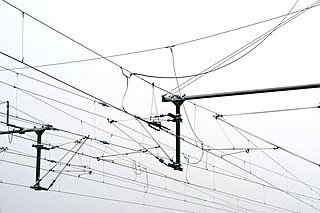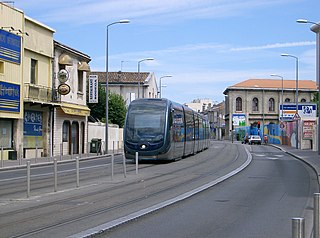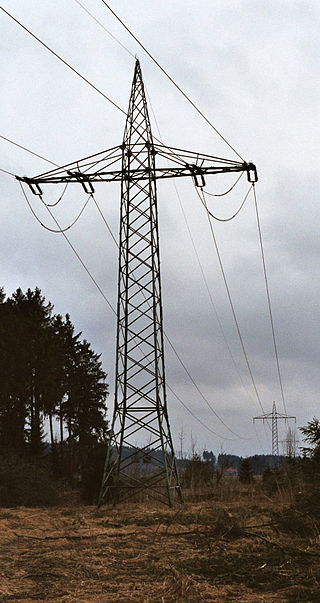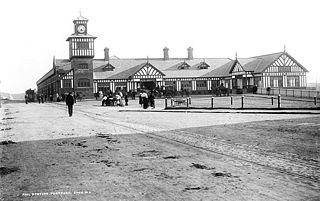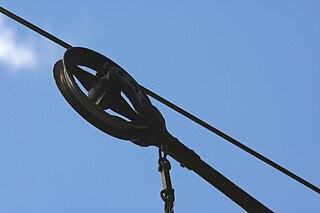Systems using standard voltages
Voltages are defined by two standards: BS EN 50163 [1] and IEC 60850. [2]
Overhead systems
600 V DC
| Country | Location | Name of system | Notes |
|---|---|---|---|
Worldwide | Many tram systems | This voltage is mostly used by older tram systems worldwide but by a few modern ones as well. See List of tram systems by gauge and electrification. | |
| Germany | Trossingen | Trossingen Railway | |
| Hungary | Budapest | Budapest Metro | Line M1 |
| Japan | Chōshi, Chiba | Chōshi Electric Railway | |
| Kyoto, Kyoto | Eizan Electric Railway | ||
| Kanagawa | Enoshima Electric Railway | ||
| Matsuyama, Ehime | Iyotetsu Takahama Line | ||
| Shizuoka, Shizuoka | Shizuoka Railway | ||
| Romania | Sibiu county | Sibiu-Răşinari Narrow Gauge Railway | Part of the former Sibiu tram line |
| Spain | Madrid | Madrid Metro | Lines 1, 4, 5, 6 and 9. In process to be converted to 1500 V |
| United Kingdom | Crich, England | National Tramway Museum | |
| United States | Boston | MBTA subway | Green and Mattapan Lines, the at-grade section of Blue Line northeast of Airport station |
| Cleveland | RTA Rapid Transit | Red Line | |
| San Diego | San Diego Trolley | ||
750 V DC
1,200 V DC
1,500 V DC
3 kV DC
| Country | Location | Name of system | Note |
|---|---|---|---|
| Belgium | Belgium National Railways (SNCB) | National standard. 25 kV AC used on high speed lines and some lines in the south (see below). | |
| Brazil | Rio de Janeiro | SuperVia Trens Urbanos | |
| São Paulo | São Paulo Metropolitan Trains | ||
| Chile | Empresa de los Ferrocarriles del Estado | ||
| Czech Republic | Správa železnic | Northern part of network only (approx. the Děčín – Praha – Ostrava route). The system change stations are Kadaň-Prunéřov, Beroun, Benešov u Prahy, Kutná Hora hl.n., Svitavy, Nezamyslice, Nedakonice. The southern part uses 25 kV 50 Hz (see below). The 3 kV system is to be phased out in favour of 25 kV AC. [10] | |
| Estonia | Tallinn | Elron | Commuter rail only |
| Georgia | Georgian Railways | In fact 3,300 V | |
| Italy | Rete Ferroviaria Italiana | 25 kV AC used on new high speed lines (see below) | |
| North Korea | Korean State Railway | National standard | |
| Latvia | Latvian Railways | Commuter rail only. | |
| Morocco | ONCF | National standard | |
| Netherlands | ProRail | Planned | |
| Poland | Polish State Railways | National standard. Planned high speed lines in Poland will use 25 kV AC [11] | |
| Warsaw and suburbs | Warszawska Kolej Dojazdowa | 600 V DC until 27 May 2016 | |
| Russia | Russian Railways | New electrification use only 25 kV AC (see below), except Moscow Central Circle and other interconnection lines in Moscow, and 2 interconnection lines (Veymarn line and Kamennogorsk line) in St. Petersburg. Sverdlovsk railway and West Siberian railway to be converted to 25 kV AC. | |
| Slovakia | Slovak Republic Railways (ŽSR) | Northern main line (connected to Czech Republic and Poland) and eastern lines (around Košice and Prešov), conversion to 25 kV AC planned, [10] and the broad gauge line between Košice and the Ukraine border (it will remain 3 kV until new broad gauge line construction, then convert to 25 kV AC), planned new broad gauge line is supposed to use 25 kV AC. Currently, the part north and east of the station Púchov uses 3 kV DC, the rest uses 25 kV 50 Hz (see below). | |
| Slovenia | Slovenian Railways | National standard | |
| South Africa | Transnet Freight Rail; Metrorail | National standard; also 25 kV AC (see below) and 50 kV AC used | |
| Spain | Administrador de Infraestructuras Ferroviarias | 25 kV AC used on high speed lines (AVE) (see below) | |
| Ukraine | Ukrainian Railways | In east (Donetsk industrial zone), in west (west from L'viv – connecting to Slovakia and Poland), to be converted to 25 kV AC [12] (see below) | |
15 kV AC, 16+2⁄3 Hz / 16.7 Hz
| Country | Location | Name of system | Notes |
|---|---|---|---|
| Austria | ÖBB | National standard. Planned new high speed lines will near the border use 25 kV AC: Innsbruck-Italy and broad gauge to Ukraine. Austrian national railways also operating small country Liechtenstein where is alson used 15 kV AC. | |
| Czech Republic | Znojmo - Retz | Správa železnic | Isolated section near border with Austria |
| Germany | Deutsche Bahn - German National Railways (DB) | National standard | |
| Norway | Norwegian National Rail Administration | ||
| Sweden | Swedish Transport Administration | ||
| Switzerland | Canton of Bern | BLS | |
| Central Switzerland and Bernese Highlands | Zentralbahn | ||
| Canton of Vaud | Chemin de fer Bière-Apples-Morges (BAM) | ||
| Canton of Zürich | Sihltal Zürich Uetliberg Bahn | ||
| Swiss Federal Railways (SBB CFF FFS) | |||
25 kV AC, 50 Hz
| Country | Location | Name of system | Notes |
|---|---|---|---|
| Argentina | Buenos Aires | Roca Line | Constitución – Ezeiza Constitución – Alejandro Korn Constitución – Bosques Constitución – La Plata |
| Australia | Brisbane, North Coast line, Blackwater and Goonyella coal railways | Queensland Rail | |
| Perth | Transperth | ||
| Adelaide | Adelaide Metro | Seaford/Flinders and Gawler lines electrified | |
| Sydney | Sydney Metro | Completely new lines (Western Sydney Airport and Sydney Metro West) converted lines use 1500V DC [6] | |
| Belarus | National standard | ||
| Belgium | Belgium National Railways (NMBS/SNCB) | High-speed lines and some other lines. The rest of the network is 3 kV DC (see above) | |
| Bosnia and Herzegovina | |||
| Botswana | Proposed line to Namibia | ||
| Bulgaria | Bulgarian State Railways | ||
| China | China Railway | National standard | |
| Beijing | Beijing Subway | Daxing Airport Line only | |
| Chengdu | Chengdu Metro | Lines 17, 18 and 19 only | |
| Wenzhou | Wenzhou Rail Transit | ||
| Croatia | Croatian Railways | Lines Zagreb-Rijeka and Rijeka-Šapjane formerly used 3kv DC traction | |
| Czech Republic | Správa železnic | Southern lines only (linking Karlovy Vary – Cheb – Plzeň – České Budějovice – Tábor – Jihlava – Brno – Břeclav – Slovakia), northern lines use 3 kV DC (see above) | |
| Denmark | Banedanmark | National standard, excluding Copenhagen S-train | |
| Djibouti | Addis Ababa–Djibouti Railway | Ethiopian Railway Corporation | |
| Ethiopia | Addis Ababa–Djibouti Railway | Ethiopian Railway Corporation | |
| Finland | National standard | ||
| France | North and new lines | SNCF | A number of lines also electrified with 1.5 kV (see above) |
| Germany | Harz | Rübelandbahn | |
| Greece | Hellenic Railways Organisation | National standard | |
| Hong Kong | Kowloon, New Territories | MTR | East Rail and Tuen Ma lines |
| Hungary | Hungarian State Railways and Raaberbahn | ||
| India | Indian Railways | Entire IR network uses the current system since 2016. | |
| Mumbai | Mumbai Suburban Railway | Conversion from 1.5 kV DC to the current system was completed in 2012 (for Western line [13] ) and 2016 (for Central line [14] [15] [16] ) respectively | |
| Mumbai | Mumbai Metro (Line 1) | ||
| Chennai (Madras) | Chennai Metro | ||
| Delhi | Delhi Metro | ||
| Hyderabad | Hyderabad Metro | ||
| Pune | Pune Metro | ||
| Nagpur | Nagpur Metro | ||
| Jaipur | Jaipur Metro | ||
| Lucknow | Lucknow Metro | ||
| Iran | Planned | ||
| Israel | Israel Railways | Construction contract awarded in December 2015. [17] Initial test runs began December 2017. | |
| Italy | Rete Ferroviaria Italiana (Italian Railways Network) | New high-speed lines only, other lines use 3 kV DC (see above) | |
| Japan | Kantō (northeast of Tokyo), Tōhoku, and Hokkaido regions | JR East Tohoku Shinkansen, Joetsu Shinkansen, and Hokuriku Shinkansen (sections between Tokyo – Karuizawa, and between Jōetsumyōkō – Itoigawa) JR Hokkaido Hokkaido Shinkansen | 25 kV AC 60 Hz in some areas (see below). |
| Kazakhstan | |||
| Laos | Boten–Vientiane railway | ||
| Latvia | Latvian Railways | Eastern lines only (planned) | |
| Lithuania | Kena — Kaunas and Lentvaris — Trakai | Lithuanian Railways (LG) | Electrification of Naujoji Vilnia – Kena — Gudogai (BCh) route for Vilnius – Minsk (Belarus) services is established on 2017. Further Kaunas – Klaipeda and Kaunas – Kybartai corridors electrification will follow projects. |
| Luxembourg | Chemins de fer luxembourgeois (CFL) | National standard | |
| Malaysia | Padang Besar – KL Sentral – Gemas | KTM ETS (run through West Coast railway line), Keretapi Tanah Melayu Berhad | Under construction: Hat Yai (in Thailand) – Padang Besar (to be opened by 2020) and Gemas – Johor Bahru (to be opened by 2022) |
| Bukit Mertajam – Padang Regas and Butterworth – Padang Besar | KTM Komuter Northern Sector, Keretapi Tanah Melayu Berhad | ||
| Batu Caves – Pulau Sebang/Tampin, Tanjung Malim – Port Klang and KL Sentral – Terminal Skypark | KTM Komuter Central Sector (Seremban Line, Port Klang Line and Skypark Link), Keretapi Tanah Melayu Berhad | ||
| KL Sentral – KLIA2 | Express Rail Link (KLIA Ekspres and KLIA Transit) | ||
| Montenegro | Belgrade–Bar railway and Nikšić–Podgorica railway | Railways of Montenegro | |
| Morocco | Kenitra–Tangier high-speed rail line | ONCF | Casablanca–Kenitra section of high-speed rail remains at 3 kV DC [18] |
| Namibia | Proposed line to Botswana | ||
| Netherlands | HSL-Zuid high speed line and Betuweroute freight line | Nederlandse Spoorwegen | 1.5 kV DC used on the rest of the network (see above) |
| New Zealand | Auckland | Auckland suburban | 77 km between Swanson and Papakura; first service 28 April 2014 |
| Central North Island | North Island Main Trunk | 411 km between Palmerston North and Hamilton | |
| North Macedonia | Makedonski Železnici | ||
| Poland | Hrubieszów | Broad Gauge Metallurgy Line (LHS) | A section from the border to Hrubieszów will be electrified in conjunction with the electrification of the connecting border – Izov – Kovel line in Ukraine. [19] The reminder sections will follow. |
| Portugal | Portuguese Railways (CP) | Except the Linha de Cascais (1500 V DC) | |
| Romania | Caile Ferate Romane | ||
| Russia | Russian Railways | National standard used for new electrification; some areas still use 3 kV DC (see above) | |
| Saudi Arabia | Haramain High-Speed Railway | Saudi Railways Organization | Renfe and Adif will operate the trains and manage the line until 2030 |
| Serbia | Serbian Railways | ||
| Slovakia | Slovak Republic Railways (ŽSR) | South-western lines only (around Bratislava, Kuty, Trencin, Trnava, Nove Zamky, Zvolen) and the rest of the network (except narrow gauge lines), currently 3 kV DC, to follow (see above) | |
| South Africa | Transnet Freight Rail, Gautrain | Also 3 kV DC (see above) and 50 kV50 Hz used. | |
| Spain | ADIF Alta Velocidad | High-speed lines only, other lines use 3 kV DC (see above) | |
| Thailand | Bangkok | Suvarnabhumi Airport Link | |
| Tunisia | [20] | ||
| Turkey | Turkish State Railways (TCDD) | National standard | |
| United Kingdom | Network Rail | Except Southern region and Merseyrail and Northern Ireland | |
| Ukraine | Ukrainian Railways | National standard, in most of the west; also 3 kV DC in the east (see above) | |
| Uzbekistan | |||
| Zimbabwe | Gweru – Harare | National Railways of Zimbabwe (NRZ) | De-energised in 2008. May be renewed in the future. [21] |
25 kV AC, 60 Hz
| Country | Location | Name of system | Notes |
|---|---|---|---|
| Japan | Kantō (west of Tokyo), Chūbu, Kansai, Chūgoku, and Kyushu regions | Tōkaidō-Sanyō Shinkansen Hokuriku Shinkansen (sections between Karuizawa – Jōetsumyōkō, and between Itoigawa – Kanazawa) Kyushu Shinkansen Nishi Kyushu Shinkansen | 25 kV AC 50 Hz in eastern Japan (see above) |
| South Korea | Korail | All Korail freight/passenger lines except Seoul subway Line 3 which is 1.5 kV DC (see above) | |
| Seoul | Shinbundang line | ||
| Incheon, Seoul | A'REX | ||
| Mexico | Greater Mexico City | Ferrocarril Suburbano de la Zona Metropolitana del Valle de México | [22] |
| Mexico Valley, Toluca Valley | El Insurgente | First section operating on 2023. Rest expected mid of 2024 | |
| Yucatán Peninsula | Tren Maya | Under construction. About 40% of the route to be electrified [23] | |
| Republic of China (Taiwan) | Taiwan Railways Administration | National standard | |
| Western Taiwan | Taiwan High Speed Rail | ||
| United States | New Jersey | Morris & Essex Lines, New Jersey Transit | Converted from 3,000 V DC to 25 kV 60 Hz in 1984. |
| Aberdeen-Matawan to Long Branch, New Jersey | North Jersey Coast Line, New Jersey Transit | Converted in 1978 from Pennsylvania Railroad 11 kV 25 Hz system to the 12.5 kV 25 Hz on the Rahway-Matawan ROW and 12.5 kV 60 Hz electrification extended to Long Branch in 1988. The Matawan-Long Branch voltage converted from 12.5 kV 60 Hz system to the 25 kV 60 Hz in 2002. | |
| New Haven to Boston | Northeast Corridor (NEC), Amtrak | Electrified in 2000; see Amtrak's 60 Hz traction power system | |
| Denver | Denver RTD | Opened in 2016; separate 750 V DC system for light rail | |
| Los Angeles to Las Vegas | Brightline West | Began construction in 2024, expected to be operational by 2027-28. First train to connect Las Vegas and Southern California since the Desert Wind ceased operations back in 1997. Will be the first dedicated high-speed rail route in the United States, though connection from Rancho Cucamonga to Los Angeles is not yet finalized for planning. Either would run on a new dedicated track or an electrified and upgraded portion of the route of the Metrolink San Bernardino Line. If connects to the Palmdale Transportation Center in Palmdale, it would also connect to the Metrolink Antelope Valley Line along with the California High-Speed Rail. Would connect most other rail services at Union Station in Los Angeles. | |
| San Francisco to Anaheim | California High-Speed Rail | Began construction in 2015, set to begin operation between Merced and Bakersfield in 2029-30, with the remainder of the route set to begin operation in 2033. Mostly running on dedicated tracks for most of it's route, except for portions of its route in the San Francisco Bay Area and the Greater Los Angeles Area. Will also run alongside other commuter rails, including the electrified Caltrain. However, no plans for another connecting commuter rail, Metrolink to be electrified, so will still use diesel locomotives, all the lines would connect at Union Station in Los Angeles, and some routes at other high-speed rail stations that share Metrolink service. Same would go for the connecting Amtrak routes such as the Pacific Surfliner, Coast Starlight, San Joaquins, Capitol Corridor, and the Southwest Chief. Will eventually construct Phase 2 to connect Sacramento and San Diego. | |
| San Francisco Peninsula | Caltrain | Under construction, expected by 2024; see Electrification of Caltrain | |
| New Mexico | Navajo Mine Railroad | ||
| Texas | Texas Utilities, Monticello & Martin Lake | see E25B and Internet reference [24] | |
Conductor rail systems
600 V DC conductor
All systems are third rail unless stated otherwise. Used by some older metros.
| Country | Location | Name of system | Notes |
|---|---|---|---|
| Argentina | Buenos Aires | Urquiza Line | Federico Lacroze-General Lemos |
| Canada | Toronto | Toronto subway | Only on subway lines |
| Greece | Athens | EIS/ISAP | used between 1904 and 1985 |
| Italy | Turin | Superga Rack Railway | |
| Japan | Tokyo | Tokyo Metro Ginza Line and Marunouchi Line | |
| Nagoya, Aichi | Nagoya Municipal Subway Higashiyama Line and Meijō Line | ||
| Sweden | Stockholm | Stockholm Metro | 650 V, Green and Red Lines |
| United Kingdom | Glasgow | Glasgow Subway | |
| United States | Anaheim, California | Disneyland Monorail | |
| Boston | Massachusetts Bay Transportation Authority | Red and Orange Lines, the subway part of the Blue Line southwest of Airport station | |
| Chicago | Chicago "L" | elevated and subway lines | |
| Staten Island | Staten Island Railway | ||
| New York City metro area | PATH | ||
| Philadelphia | Southeastern Pennsylvania Transportation Authority | Broad Street Line | |
| Bay Lake, Florida | Walt Disney World Monorail System |
750 V DC conductor
Conductor rail systems have been separated into tables based on whether they are top, side or bottom contact. Used by most metros outside Asia and the former Eastern bloc.
Bottom contact
Side contact
Top contact
Mixed
| Type | Country | Location | Name of system | Notes |
|---|---|---|---|---|
| See note | China | Tianjin | Tianjin Metro | Top contact in Line 1, bottom contact in Lines 2 and 3 |
1,200 V DC conductor
All systems are third rail and side contact unless stated otherwise.
| Country | Location | Name of system | Notes |
|---|---|---|---|
| Germany | Hamburg | Hamburg S-Bahn | 15 kV 16.7 Hz AC with overhead line in part of network. |
| United Kingdom | Manchester | Bury Line | Dismantled 1991, converted to Manchester Metrolink tramway (750 V DC overhead) |
1,500 V DC conductor
All systems are third rail unless stated otherwise.
| Type | Country | Location | Name of system | Notes |
|---|---|---|---|---|
| Bottom contact | France | Paris | Paris Métro Line 18 | Currently under construction |
| Toulouse | Line C (Toulouse Metro) | Currently under construction | ||
| Side contact | Chambéry – Modane | Culoz–Modane railway | used between 1925 and 1976, today overhead wire | |
| Bottom contact | China | Beijing | Beijing Subway | Line 7 only |
| Guangzhou | Guangzhou Metro | Lines 4, 5, 6, 14 and 21 only. Overhead wires in depots; all trains are equipped with pantographs | ||
| Kunming | Kunming Metro | Line 4 only | ||
| Qingdao | Qingdao Metro | |||
| Shanghai | Shanghai Metro | Lines 16 and 17 only. Overhead wires in depot of Line 16, all trains on Line 16 have pantographs for depot use. | ||
| Shenzhen | Shenzhen Metro | Lines 3 and 6 only. Overhead wires in depot of Line 6, all trains on Line 6 have pantographs for depot use. | ||
| Wuhan | Wuhan Metro | Lines 7, 8, 11 and Yangluo Line only | ||
| Wuxi | Wuxi Metro |

